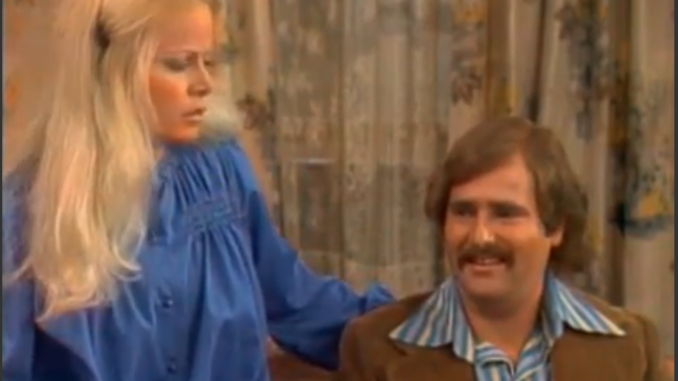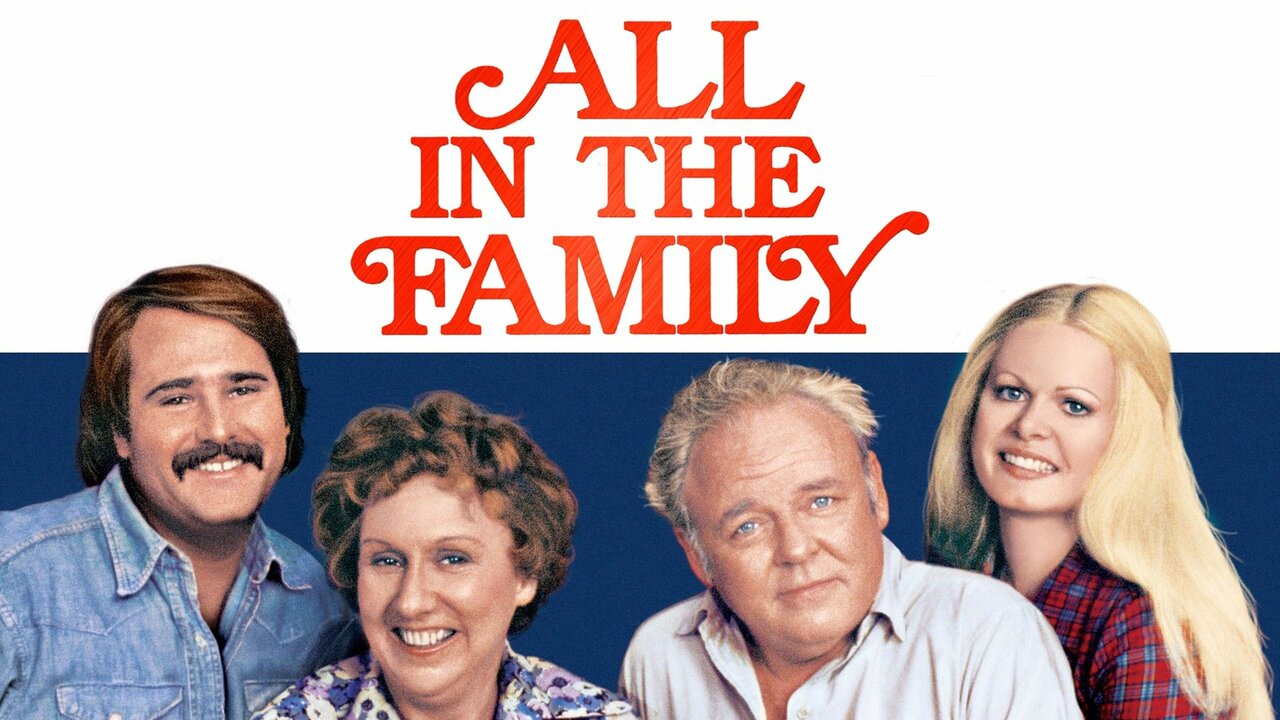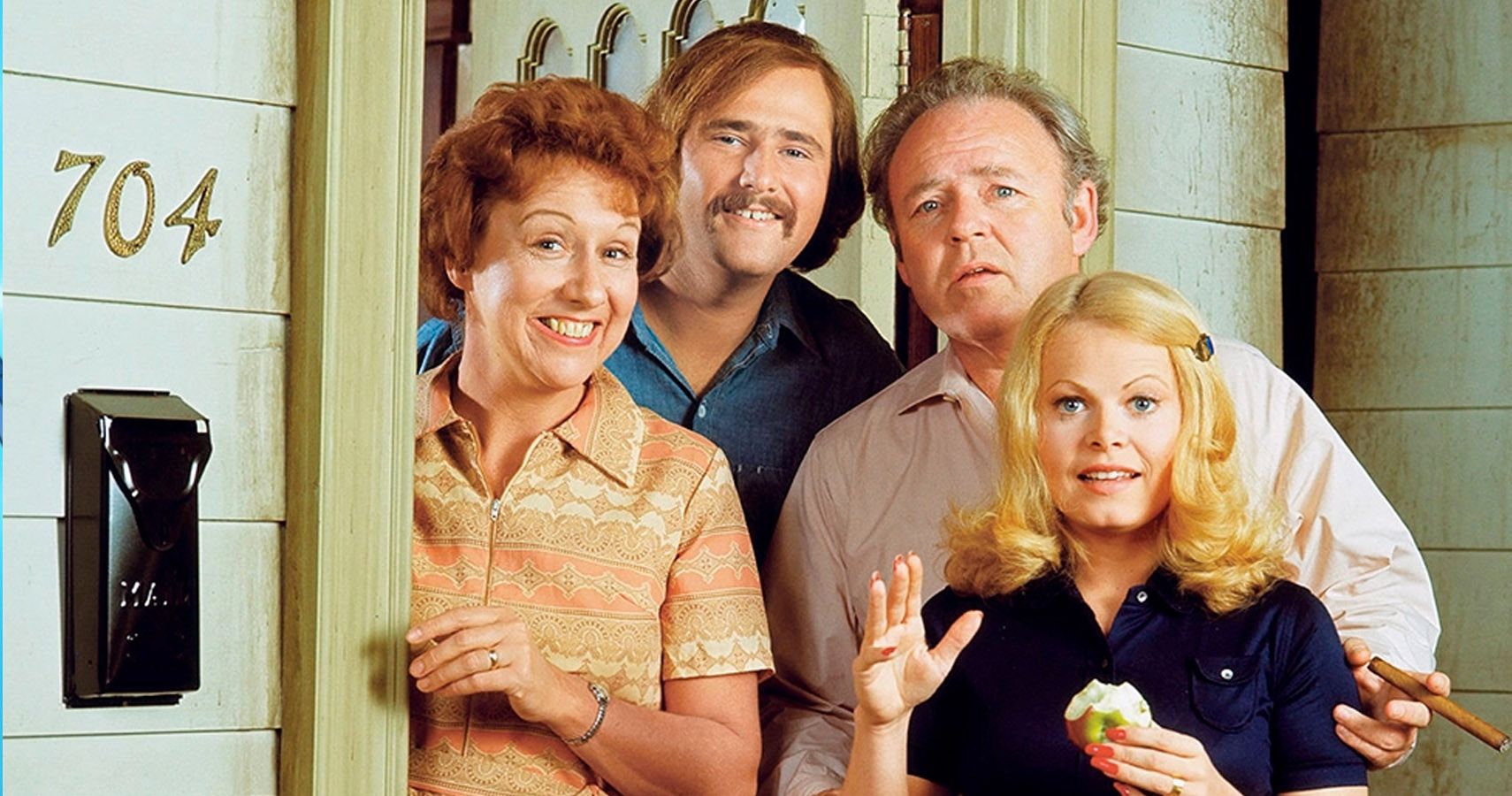
All in the Family was the first program to genuinely reckon with the cultural upheaval of 1960s America. TV would never be the same.
When cbs first placed All in the Family on the air, on January 12, 1971, it irrevocably transformed television. After a shaky first season in which it struggled to find an audience, the show prospered, rising to become No. 1 in the ratings for five consecutive years, a record unmatched at the time. All in the Family commanded national attention to a degree almost impossible to imagine in today’s fractionated entertainment landscape. Archie Bunker’s catchwords—stifle, meathead, and dingbat—all became national shorthand. Scholars earnestly debated whether the show punctured or promoted bigotry.
Its success not only helped lift The Mary Tyler Moore Show, M*A*S*H, and the other great topical comedies of the early 1970s, but also cemented the idea that television could be used to comment meaningfully on the society around it—an idea the networks had uniformly rejected throughout all the upheaval of the 1960s. That legacy—the determination to connect the medium to the moment—reverberates through shows as diverse as Fleabag, Atlanta, Breaking Bad, The Wire, and countless others. The night that CBS initially aired All in the Family was the first step on the road toward the Peak TV that we are living through today.
All in the Family condensed the “generation gap” of the 1960s into a single living room. It pitted Mike Stivic, a long-haired liberal, and his wife, the bubbly Gloria, against Gloria’s father, Archie Bunker, a reactionary bigot and Richard Nixon–loving dockworker—as Edith, the daffy but benevolent wife and mother, looked on. Incarnated by a stellar cast and energized by brilliant writing and directing, it became a television landmark, widely lauded as one of the greatest and most influential shows ever.
Initially, though, it was something of a miracle that All in the Family reached the air at all. Before CBS bought it, ABC had rejected it twice. And before All in the Family, shows that tried to achieve more relevance had almost all failed, mostly because they were too laden with good intentions to attract an audience. That All in the Family not only reached the air but prospered was the result of two men: Norman Lear, its staunchly liberal creator, and Robert D. Wood, the conservative president of CBS, who put it on the schedule. That act revolutionized television, but both men were unlikely revolutionaries.
Norman lear was the son of a man whose dreams dissolved quickly but whose resentments outlived him in the work of his son. Herman Lear was a small-time salesman and entrepreneur, and a fountain of dubious get-rich-quick schemes. His wife, Jeanette, according to Norman, was self-absorbed, discontented, and, like her husband, volatile. Later, they would become Lear’s early models for Archie and Edith Bunker. Throughout his childhood in Connecticut and Brooklyn, Lear’s parents immersed him in an environment of barely controlled chaos. The two of them, Lear would often say, “lived at the ends of their nerves and the tops of their lungs.” At the peak of argument, the veins in his neck bulging, Lear’s father would beat his fists against his chest and bellow at Lear’s mother, “Jeanette, stifle yourself.”
Like many children of the Great Depression, Lear found direction and structure in the military. After drifting through a few semesters at Emerson College, in Boston, he enlisted in the Army Air Force following Pearl Harbor and flew dozens of bombing missions over Germany. After a few years working as a Broadway press agent and, later, for his father, Lear made a decision that proved a turning point: He loaded his wife and infant daughter into a 1946 Oldsmobile convertible and pointed it toward Los Angeles. There, he hoped for a fresh start, but struggled to find work. He was reduced to selling furniture and baby photos door-to-door with a man named Ed Simmons, an aspiring comedy writer who was the husband of Lear’s cousin.
One night, Lear helped Simmons finish a parody of a popular song he had been writing. When they found a nightclub singer to buy the song, their payday was only $40 between them, but that was enough to convince the two to drop their salesman’s satchels and plunge into a full-time writing partnership. Soon after, they caught the attention of industry insiders and began writing for an early television-variety show.
Through the 1950s, Lear’s career advanced in step with the growth of television itself. These were the years of television’s so-called golden age, when earnest dramas such as The Philco Television Playhouse groomed a steady stream of young directors for Hollywood. Lear marinated in the other great television product of those years: the star-led variety shows, such as Sid Caesar’s Your Show of Shows, that drew on traditions of vaudeville and radio comedy.
Lear thrived in this world. He began to ricochet between Los Angeles and New York, mastering the breakneck pace of television production—he survived the constant deadlines, he later recalled, on Dexedrine to stay awake for all-night writing sessions and Seconal to sleep when they were over. He honed his sense of comedy, absorbing the rhythms of sketches that had to quickly grip an audience’s attention between singers and dancing acts.
His work was skilled and professional, and his shows were sufficiently successful to constantly open new doors for him. Eventually, he and Simmons ended their partnership, and Lear took up with the director Bud Yorkin, with whom he created a production company that developed both television programs and movies for Paramount.
Some of these films (including Come Blow Your Horn and Divorce American Style) managed respectable box-office returns, but none generated much critical excitement. No reviewers saw in the Lear and Yorkin movies, or their succession of television specials with soft-edged mainstream entertainers, the profile of anything new. Looking back, one Hollywood executive described them in those years as “yeoman producers, just guys that would get their heads down and do the work.” Little of Lear’s work in the 1960s signaled that he had much to say about the way America was transforming around him. “Here’s an example, and it rarely happens, of a guy who was smarter than his career,” recalled Michael Ovitz, a co-founder of Creative Artists Agency. “Norman Lear was far more intellectually proficient than the things he was doing.”
Within a few years, millions would agree, but not until Lear met another World War II veteran who was an even more unlikely candidate to transform the nature of television.
The career of robert d. wood, the CBS executive who ultimately put All in the Family on the air, proceeded almost exactly in parallel with Lear’s. While Lear served in the Army Air Force during World War II, Wood spent three years in the Navy, including time in the South Pacific. After the war, he graduated with a degree in advertising from the University of Southern California in 1949, the same year Lear arrived in Los Angeles with his young family.
Wood started his career in ad sales for the CBS radio affiliate in L.A., KNX. By 1960, he’d risen up the ranks to become vice president and manager of the network’s local television affiliate. His elevation to that role anointed him as a prince in the CBS empire. The affiliate, KNXT, was one of the five TV stations around the country that the federal government permitted CBS to own and operate directly during this period. These “O&O stations” were concentrated in the largest markets and generated enormous profits. CBS granted great autonomy to O&O general managers like Wood and marked them as future leaders. The network also pushed managers to deliver on-air editorials, like those in local newspapers, but left them almost entirely free to decide the content.
Wood thrived in this role. “He was really proud of being the editorial voice, the guy who appeared in the editorials, and he was good at it,” recalled Pete Noyes, a prominent news producer at KNXT in those years. “He had a great presence.” Wood hired Howard Williams, an editorial writer from the conservative Los Angeles Mirror, to help him develop the station’s editorial line.
Wood was a gregarious boss, with a salesman’s effortless capacity to make friends and create camaraderie. He knew everybody’s name and had time to talk to anyone. “Didn’t matter who they were … he was your buddy,” Williams said. Wood’s politics were consistently conservative, reflecting the center of gravity in L.A. media and business circles during the 1950s and ’60s, in which he mingled easily. In 1962 and 1966, respectively, KNXT endorsed Richard Nixon and Ronald Reagan for governor. In 1964, when the first demonstrations by the free-speech movement erupted at UC Berkeley, Wood, in one of his on-air editorials, called the demonstrators “witless agitators” and insisted that they “be dealt with quickly and severely to set an example for all time to those who agitate for the sake of agitation.”
A few years later, CBS promoted Wood again, relocating him to the East Coast, where he took on a succession of top-level jobs. In early 1969, Wood was named president of the CBS Television Network, the company’s highest-ranking television position.
This promotion placed him atop the most powerful and profitable of the three television networks. CBS’s preeminence was symbolized by its imposing Midtown Manhattan headquarters, an austere and dramatic spire of charcoal-gray granite known as Black Rock. From his 34th-floor office, Wood entered a Mad Men environment that appeared frozen in time. This was a more urbane, cosmopolitan, and cutthroat world than the domesticated cycle of Junior League dinners and weekends at the beach that Wood had left behind in Los Angeles. But he took to it naturally. To many around him, Wood came across as the West Coast equivalent of an Ivy Leaguer, confident and smooth, if no intellectual; he was always more comfortable discussing football than philosophy.
But for all the power and profitability that CBS projected through the late ’60s, it couldn’t entirely ignore the social changes of the era. CBS faced disruption from the same demographic-driven transformation of its audience that had staggered the movie studios and sent weekly admissions in movie theaters plummeting through the ’50s and ’60s. Like Hollywood, the television networks faced a growing disconnection between their musty products and the young Baby Boomers whose swelling numbers and growing buying power were reshaping the market for popular culture. And Wood, with his grounding in Los Angeles, felt the tremors earlier than almost anyone else around him.
In 1961, newton minow, the chairman of the Federal Communications Commission, disparaged television as “a vast wasteland.” But he would have been just as accurate to call it “a vast cornfield.”
Through the 1960s, the networks stubbornly looked away from the simultaneous earthquakes disrupting American life: the civil-rights and antiwar movements, the nightly carnage of Vietnam, the rise of the drug culture, the sexual revolution, and the feminist awakening. Instead, they mostly offered viewers a gauzy, pastoral vision of America.
With only three networks, shows needed to attract enormous viewership to survive. The prevailing aim at the networks and the advertising agencies was to produce what became known as “the least objectionable program” that could draw the most diverse viewership. In practice, this translated into shows that would be acceptable not only to urban sophisticates but also to small-town traditionalists. So, off the CBS assembly line flowed a procession of banal comedies celebrating the simple wisdom of rural life, including The Beverly Hillbillies and The Andy Griffith Show. Surrounding them were variety shows and comedies led by aging figures from the ’50s and even earlier, such as Ed Sullivan and Lucille Ball. Each night, CBS chronicled the tumultuous strains tearing at America on Walter Cronkite’s newscast and then spent the next three and a half hours of prime time trying to erase them from viewers’ minds.
CBS’s first attempt to reflect the changing culture came in 1967, when it premiered The Smothers Brothers Comedy Hour. The Smothers Brothers, Tom the leader and Dick the straight man, were a modestly successful duo who had built an audience through albums and a nightclub act that combined stand-up comedy with gentle parodies of folk music. Their show was a hit from the outset and quickly became the one spot on television that seemed conscious of the burgeoning youth culture. Cutting-edge bands such as Buffalo Springfield, the Byrds, The Who, and Simon and Garfunkel all appeared.
As the show’s audience grew, Tom Smothers in particular became determined to use the platform to deliver a distinctly liberal message about contemporary issues, especially the Vietnam War. Tom said, “There’s no point of being on television … at this point in time, with what’s going on in this country, and not reflect what’s going on,” recalled Rob Reiner, the future All in the Family star, who joined the show for part of its final season as a writer. CBS censors predictably recoiled, snipping lines from some segments and rejecting others completely. The show had supporters inside CBS, but the network’s senior leadership grew weary of the constant arguments. Wood canceled the show in early April 1969, less than two months after he’d assumed the network’s presidency.

